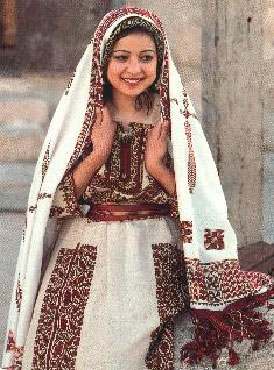Only one kind of stitch is used in making Palestinian embroidered dresses but the patterns and colors used for these dresses vary. The color combinations of the embroidery, the design and the color of the cloth on which the embroidery is made, have specific connotations as to the specific region in Palestine where the article was made or the status of the person owning or wearing the article (in the case of women’s dresses, called thobes, the status may be a new bride, an older mother, a pregnant wife, etc.)
One can determine where a Palestinian woman comes from through the patterns of the embroidery on her dress; almost each Palestinian town has its own unique pattern. Palestinian embroidery is an integral part of the Palestinian geographical and cultural landscape.
While many of the patterns used in Palestinian embroidery are designs of geometric shapes, they also include designs which were most familiar to Palestinian women as impressions of their daily surroundings. Depending on the region in Palestine, the patterns included representations of cypress tree, bunches of grapes, apple tree, cauliflower, cock, pigeon, rainbow, roses, birds, flower pot and extensive other such representations. Geometric designs were given such names as 'foreign moon', 'cow's eye', 'mill wheel', 'crab' , 'moon with feathers', 'old man's teeth', 'bachelor's cushion', the baker's wife', 'old man upside down' and other such creative and often humorous names.
At the beginning of the 20th century Palestinian costume could be classified by specific region, tribe or community, and as a nomadic Bedouin costume, fellahin village dress and urban dress.
Today costume styles are best classified as refugee camp styles, Palestinian Territories styles and Bedouin costume. Only among the Bedouin does costume still retain elements of its traditional pre-1948 role. The styles of clothing worn today in the Palestinian Territories and in the refugee camps include Western dress and Islamic modesty dress as well as various forms of the so called "traditional" embroidered dresses. What is now identified as "traditional" is a much simpler garment in terms of construction and decoration.
20 Bakers' Wife 21 Cockscomb 22 Old Man Upside Down 23 Apples 24 Snail 25Chicken Feet 26 Zigzag
The late 1960s saw the development of the "6 branch dress" style, named after the six vertical bands of embroidery that ran from waist to hem. Its widespread popularity marks it as the first post-1948 style to evolve without being tied to an established regional style. The "6 branch" is characterized by its curvilinear foliage and flower designs and its various "branches of birds" motifs (not all of which were actually birds). The patterns are primarily European. Preferred threads for embroidery were perle cotton, with multicolored shaded threads popular in the 1970s and early 1980s.
Palestinian embroidery did not, with rare exceptions, include patterns with any religious symbols. In Palestinian society, religion was a personal matter between. A phrase which was very popular in Palestinian society during all of the twentieth century was "Religion is for God, but the country is for everyone" (adeenu lillah wal watan liljamee') which meant that no one wanted the differences in religious beliefs to impact societal relations among Palestinians. Nonetheless, Christian minorities have made embroidered articles with Christian representations for the use in their churches for religious rituals and ceremonial purposes.
Today Palestinians market embroidered cushions, shawls, jackets and modern usable articles besides the traditional village dress. These are for the most part produced in the Palestinian refugee camps through various women’s organizations and co-operatives both as a livelihood and as a way to maintain the tradition. Each camp or aid organization has over time developed certain stylistic characterizations.
sources : http://palestinianembroider.tripod.com/traditional.htm ; http://www.palestine-net.com/misc/inaash.html ; http://www.palestinecostumearchive.org/contemporary.htm




